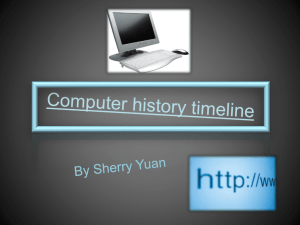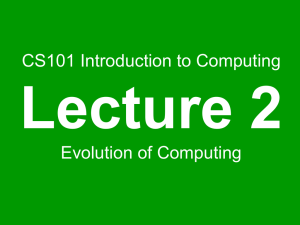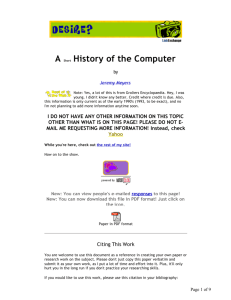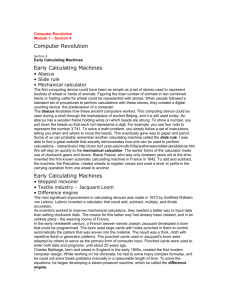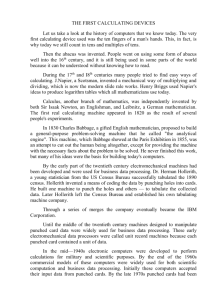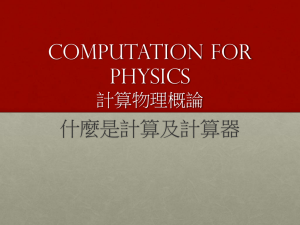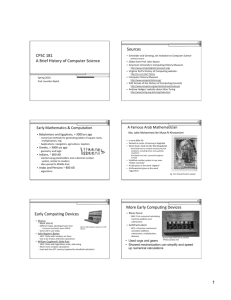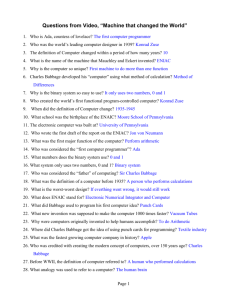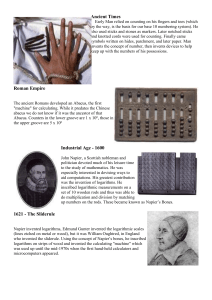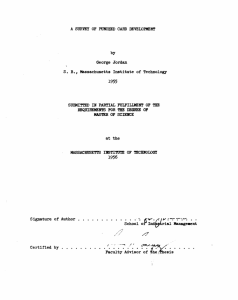CSE 1520 Computer Use: Fundamentals
advertisement
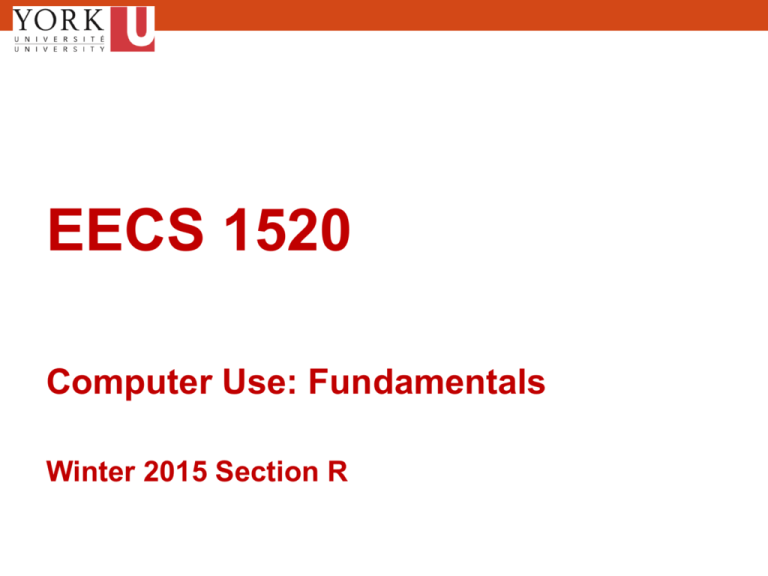
EECS 1520 Computer Use: Fundamentals Winter 2015 Section R Introduction – Course Overview Instructor: John Lam Office: Lassonde Building 1012G E-mail: johnlam@cse.yorku.ca Lectures: Monday, Wednesday & Friday 10:30am – 11:30am Office hours: Monday 1:30pm – 3:30pm Course website: http://www.eecs.yorku.ca/course_archive/2014-15/W/1520R/ 2 2 Introduction – Course Overview Evaluation: • 9 Homework (2% each = 18%) • Weekly, paper printouts in dropbox (dropbox located on the first floor of Lassonde Building, labelled EECS 1520) • Tests (first: 15%, second: 20%) • In class, approx. 50 minutes long • NO MAKE-UP TESTS ARE ALLOWED • Final exam (47%) • Content: all topics (topic A to F) 3 3 Introduction – Course Overview How to do well in the course? • Do all the homework (2% each = 18%) • Write both tests (first: 15%, second: 20%) • Attend lectures • Read the text and study all the notes • Ask questions! 4 4 Week 1: The History of Computing (PART I) • READING: Chapter 1 5 Computing Systems • A computing system is composed of hardware and software, and the data that they manage • Hardware: circuit boards, chips, keyboards, printers, monitors and so on. • Software: collection of programs, instructions 6 6 History of Computing Hardware: Abacus • Abacus is an early computing device that uses positional notation to represent a number • The beads in any one column represent the digit in that column • The user performs basic arithmetic calculations by moving the beads rods Upper deck beads Lower deck 7 7 History of Computing Hardware: Blaise Pascal: Pascaline (1642) • The Pascal’s Calculator was a gear-driven mechanical machines that performed whole-number addition and subtraction • The calculator had spoked metal wheel dials, with the digit 0 through 9 displayed around the circumference of each wheel. • The machine has to be re-zeroed before each new operation 8 8 History of Computing Hardware: Jacquard’s loom (1801) • Although not a computing device, Jacquard’s loom was the first to make use of the punched cards • The mechanical loom used a series of cards with holes punched in them to specify the use of specific colored thread Multiple rows of holes were punched on each card, with one complete card corresponding to one row of the design. 9 9 History of Computing Hardware: Charles Babbage: Difference engine (1822) • Known as “father of the computer” • Began the concept of programmable computer • His “difference engine” is an automatic mechanical calculator designed to tabulate polynomial functions. It was created to calculate a series of values automatically. 10 10 History of Computing Hardware: Charles Babbage: Analytical engine (1843) • The analytical engine was programmed using punched cards • Punched cards were used to perform arithmetic operations, define numerical constants, and perform loading and storing numbers operations • His design was the first to include a memory so that intermediate values did not have to be reentered 11 11 History of Computing Hardware: Ada Lovelace (Ada Byron) • World first computer programmer • Worked as Babbage’s assistant on Babbage’s Analytical engine • She translated a paper by Italian military engineer Luigi Menabrea on the Analytical engine, in which she also supplemented with an elaborate set of notes of her own, simply called Notes. • These notes contain what many consider to be the first computer program— that is, an algorithm designed to be carried out by a machine 12 12 History of Computing Hardware: Herman Hollerith: Tabulator • Known as “father of modern machine data processing” • He developed a electro-mechanical tabulator based on punched cards to rapidly tabulate statistics from millions of pieces of data • His invention was used for the 1890 census in the US. • He later formed a Tabulating Machine Company in 1896, known today as IBM. 13 13 History of Computing Hardware: Alan Turing • Known as “father of theoretical computer science and artificial intelligence” • He objects Ada Lovelace’s idea that machines are incapable of independent learning • He was highly influential in the development of computer science, providing a formalisation of the concepts of "algorithm" and “computation" with the Turing machine • The Turing test is a test of a machine's ability to exhibit intelligent behavior equivalent to, or indistinguishable from, that of a human 14 14 History of Computing Hardware: Alan Turing • During the Second World War, he devised a technique breaking the Nazi Germany’s Enigma machine’s code, a electro-mechanical cipher machine for enciphering and deciphering secret messages. • Invented in 1918, it was the most sophisticated code system of its day, and was a priority of the Allies to decipher before D-Day so that they could be certain that they had fooled the Germans about the Invasion of France 15 15 History of Computing Hardware: Alan Turing: Imitation Game • In his 1950 paper "Computing Machinery and Intelligence," Turing asked the question: “Are there imaginable digital computers which would do well in the imitation game?” 16 16 History of Computing Hardware: ENIAC • ENIAC (Electronic Numerical Integrator And Computer) at the Moore School of Engineering, University of Pennsylvannia, the first electronic generalpurpose digital computer using vacuum tubes • operational in 1946 • capable of being reprogrammed to solve "a large class of numerical problems" 17 17 History of Computing Hardware: ENIAC 18 18 History of Computing Hardware: John Von Neumann • Von Neumann visits the Moore School in 1944 and prepares a draft for an automatic programmable device (later called EDVAC) • “Stored-program” concept • fetch-decode-execute” instruction cycle 19 19
